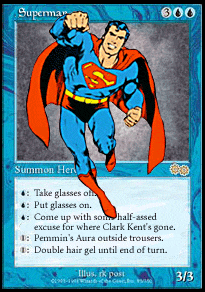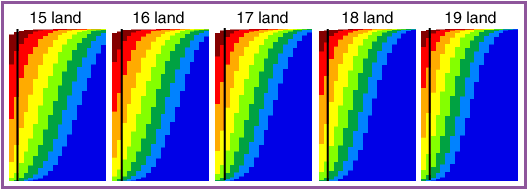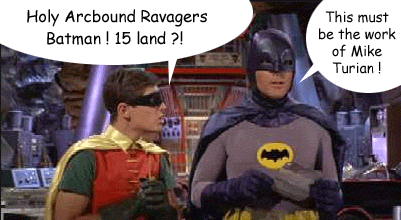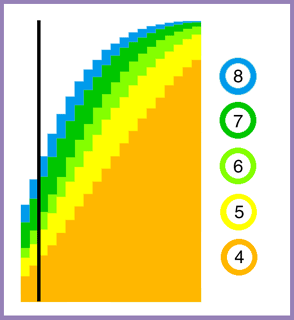
It might just be the single most important question in the world today. In a fight, who would win out of Batman and Superman?
I'm guessing some of you probably answered "Superman" straight away. If so, just pause for a minute and think about Lex Luthor. He's given Superman no shortage of trouble over the years. Is he smarter than Batman? More resourceful? The question is surprisingly controversial.

I'll come back to this vital question in a minute. Hopefully you won't mind if I take a break for a bit to talk about Magic?
Back when you were knee high to a grasshopper, your Grandma taught you to run 17 lands in your Limited decks. Maybe you remember the wild, crazy days of Mirrodin block when 16 was solid and the cool kids dared wild things with just 15 land? Or maybe you like your decks slow and cautious and 18 land is your motto. Stop! Look me in the eye and answer truthfully - do you know why?
One day, after a particularly severe mauling at the hands of my own mana supply, I decided I was fed up with the received wisdom. I wanted to actually understand the arcane art of mana bases. Now look at the picture down there on the right. Psychedelic, eh? Sorry about that. I was born in the '70s and I can't help it. I've managed to stop wearing corduroy, avoid six inch sideburns and resist the temptation to put a poster of Che Guevara on my bedroom wall. Truth is, I don't even like his music. Rainbow colours are my one concession to my roots.

So what does each column show ? Each possible number of land is represented by a different color. I don't want to talk maths any more than you want to read it, so let's look at a quick example instead. Like most players I hate drawing one-land hands. If I look at the dark red bar in the third column (just to the right of the black line) this tells me how likely it actually is. Just compare the height of the relevant bit with the height of the whole diagram. As you can see, it's not very likely. What's nice about the diagram (apart from the rainbow colours) is that it's more immediately intuitive than if I said the chance is 5.8%. If that was the only point of it I might as well not have bothered, but fortunately it also helps us answer questions about Superman vs. Batman.
For much of human history we have fondly believed we were good with numbers. Not to put too fine a point on it, but this is because we were comparing ourselves to cows, dogs and small rocks. Now we've invented computers the truth is finally revealed: we suck with numbers. On the plus side, our ability to understand images is second to none. If we look at the psychedelic diagram again, what we see is: S-shapes!
The implications of this for our Magic play are quite serious. In fact, they're so serious that I'm going to put down my pipe, push my spectacles down to the end of my nose and lean forward in my armchair with a stern look on my face as I explain. What this S-shape means is that for each possible mana cost our spells might have there is a sweet spot in terms of game turns when the chance of casting them suddenly rises. Before I'd thought about it I always assumed that this was a consequence of the "one land per turn" rule. But it isn't, because our diagram takes no account of that rule!
This means our 17 land deck (on the play) will usually manage its two-drops on turn two and three-drops on turn three. Four drops on turn four are a bit more dubious. Just to make sure you're still with the plot here: you should be looking at the yellow bit of the fourth column right from the black line. It's the bit above the top edge you care about (because below the bottom edge you have more than four land, which means you still make your fourth drop). Still, the chances of a fourth land by turn 4 are reasonably high. By the time we're looking for a fifth land on turn 5 we're going to have to be lucky. It's still more likely than not, but if something goes wrong nearly half the time we don't want to rely on it.
So this is why a typical Limited deck should be focussing its strength around three drops and four drops. It's because you want to be running the strongest cards you can play reliably.
You've noticed that "S" Superman has on his chest, right ? Do you think it's a coincidence that our mana diagram is also S-shaped?
Actually it is a coincidence. Back to the Superman vs. Batman question and I think you're ready for the answer now: It depends.

That's some far out freaky retro wooberg man!
Imagine Superman and Batman are both in the middle of a football field, stripped naked and... No, wait, that's way too homoerotic. Let me try again. Imagine Superman and Batman are both in the middle of a football field with no special equipment and no chance to set anything up in advance. They both know they're fighting each other. Zap! Pow! Superman wins.
Now imagine Superman and Batman are going to have to fight but they don't know it yet. Batman figures it out first, works out how to beat Superman and the fight is won before it even starts. There was kryptonite in his lunchtime can of Red Bull. How did that happen?
See? It depends. And that's also the answer to the question of how many lands you want to be running.
This is one of those curious facts that seems obvious until you think about it and then turns out to be true anyway. Before things get any more confusing, we need an example!
No... wait... we do need an example, but first we need more psychedelia!

I realize it's a lot of information to take in, so don't stare at it too hard. Let's get straight on to the example:
Let's say you've just drafted a fast R/W deck with Fumiko the Lowblood, Nagao and lots of good combat tricks. As it happens, your only six drop is a Kami of the Palace Fields which isn't a great fit with the rest of your deck. You also have only two five drops in the form of a pair of Frost Ogres. How many land should you run ? We'll consider each option in turn:
15 - You might think that a deck full of small, fast attackers would like to run as few lands as possible. Unfortunately it doesn't work. Comparing when your four-drops come down it takes until turn six here to reach the same odds of playing a four drop as an 18 land deck has on turn four. That's bad. That's really bad. In exchange for this we get to run three extra non-land cards. On average we'll see one of them during a game. Is one card worth delaying our main threats by two turns. No!
16 - A more realistic option for a low land count? Looking at our yellow areas this does seem to be the case. Our four-drops now seem reliable almost a full turn earlier. On the other hand that's still turn five not turn four. Also, we still have a slightly worrying risk of not playing three drops on turn three. On the plus side, we still get to squeeze two extra cards into the deck compared to 18 land.
17 - Most of us would follow Grandma's advice without thinking about it. And in fact, it looks to be a pretty solid choice. Four drops come down on turn four acceptably often and it doesn't look like we'll have to mulligan too often based on low land counts alone. We do now have to worry about a new problem too. Take a look near the bottom of the column just to the right of the black line. The chances of 4, 5 and 6 land hands are creeping up a bit. That will mean needing to mulligan a fair few hands due to lack of spells.
18 - Casting reliability is unsurprisingly getting quite good here. The question is, will we draw enough gas to finish the job ? By turn 10 we'll have our eighth land about half the time. For this deck, that's bad news indeed.
19 - We don't even need to look. If 18 looked bad, this is only going to be worse.
OK, so no huge surprises so far. Now it's time to shock you out of your complacency! Without looking, tell me which land count gives the best odds of between two and four land in your initial hand? OK, now stare deep into the rainbow diagram. No, I haven't faked the data, it's really true: 15 land is the winner!

You will recall my answer to both of the questions under discussion was: "it depends". Hopefully now it's clear why both the question and the answer were not as obvious as they first seemed.
The decision between 15, 16, 17 and 18 land comes down mostly to the relative importance of the deck's two, three and four drops. In other words, I haven't told you what you need to know about the deck to make the decision. We need to know:
* What are the 23rd, 24th and 25th cards we have the option to add?
* How many quality two drops, three drops and four drops do we have? (Did the draft go a bit wrong, leaving us with an odd mix?)
* How much evasion does the deck have? Is it completely awful in the late game?
* How does the deck generate card advantage (if at all)?
Actually I've just had another thought. Robin, the Boy Wonder might get involved. No, no, I don't mean involved in the naked-on-a-football-field scenario! I mean in the fight. So Superman's got Batman cornered and wants to deliver a short speech before the coup-de-grace. Suddenly, WHAM! George Michael and Andrew Ridgeley step onto the stage and launch into the opening bars of Club Tropicana. Then they apologise and leave when they realise I just meant the onomatopoeic combat sound effect caused by a kryptonite batarang hitting Superman in the back of the head. WHAM! Superman's knocked out. Robin unties Batman and the Dark Knight claims victory.
Meanwhile back at our R/W deck, let's contruct some examples of when we'd want each of the land counts we considered.
15 - Your spare cards are all playable, low cost cards like Battle-Mad Ronin, Devoted Retainer and Call to Glory which have synergy with your main deck but otherwise wouldn't make the cut due to lack of raw power. Also, you have no real late game and need to win with serious beatdown. Probably you have cards like Unearthly Blizzard and Lava Spike in your main deck. Also, your deck is overall weak enough that you feel you need a bit of luck on your side.
16 - Your spare cards are all at least somewhat playable. Also, you have no real use for spare mana. So, in particular, you don't have any real splice potential. Your late game is somewhat weak and you have no real way to generate card advantage. Trying to win the early game is your main strategy.
17 - Your deck is solid and you don't want to take risks with your three and four drops. Decent three drops like Ronin Houndmaster, Kitsune Blademaster, Kabuto Moth and Waxmane Baku mean significant rewards for playing them on time. The other possibility is that you have cards like Blessed Breath and Candle's Glow which reward you for leaving mana open after playing threats in the midgame.
18 - Your spare cards are a bit mediocre. Maybe a Kami of the Painted Road, an Akki Avalanchers and an Ire of Kaminari are your best options. However, your cards are mostly solid with your three and four drops being much stronger than your two-drops. Also perhaps you have a Glacial Ray and a few splice opportunities for which extra mana is always welcome.
19 - You forgot to mention, your deck also includes Yosei and Ryusei. Oh, and a Myojin of Infinite Rage in your sideboard. Also, the need to rebel against your grandma burns passionately within you.
Distilling these five paragraphs down to a simple and easily memorable rule, the question you have to ask is: "When my deck wins, why does it win ?"
I said the deck was fast, so the answer is something to do with tempo. Still, there's a world of difference between "It wins because my opponent cannot deal with an early Nagao or Fumiko" and "It wins because my early drops do so much damage that Lava Spike becomes good" and "It wins because my burn and other removal stops the opponent stabilising".
At the end of the day, the answer will still be "run 17 land" more often than not. Grandma knows what she's talking about. And in exactly the same way, Superman wins in more situations than Batman.
Take a quick coffee break. You've earned it. Then come back when you're ready for more psychedelia because we've got two much trickier questions to move on to next...
Here is the first tricky question: How many lands do you need in each color ?

The first thing you'll probably notice here is that the usual rule of using three lands to support a splash is actually quite risky. There's a pretty significant risk that you won't see mana for your splash color until after the game is over. And it starts to look like Adam Chambers was really pushing his luck. In the finals of GP Chicago he ran a Honden of Seeing Winds supported by only two Islands. Bzzzt! What? Mana fixing? Oh yes, good point, he was running two Sakura-Tribe Elders. He also had a Sensei's Divining Top and Commune with Nature maindecked. I'll come back to this in a minute.
Back to the bit I'm trying to get you to remember: It depends. What depends? In this case, the number of lands you should use to support a splash. Take a quick look at the diagram. The chances of drawing the land for your splash rise rapidly as the game proceeds. How many lands you splash therefore varies with how soon you need to see one. Splashing Keiga off three islands makes a whole lot more sense than splashing Honden of Infinite Rage off three mountains. It's not just that Keiga's the better card, it's that you need the mountain for the Honden as early as possible.

What about triple mana costs ? You don't need a table for that! If you're running a card with a triple-colored cost in one of your colors you'll have to devote at least half of your lands to that color, so the tricky part will be supporting your cards in your other color. Anyway, it's only Jugan you'd care about right now and I'm not drawing you a table just for decks with Jugan in. So there.
You know how it is when you're watching a TV show and you just know what's going to happen next? I don't want to ruin your suspension of disbelief here, but Batman and Superman are both fictional characters. So in fact we've probably been answering our question all wrong. The real answer is all down to the story. If it suits the writer for Batman to win, he'll win. The relative strengths of the two characters really aren't relevant to the odds. So if we understand the plot, we can answer what might otherwise be a very complex question in a very simple way and expect to get the right answer pretty reliably.
Compensating for mana acceleration just needs a trick too.
How much help is Kodama's Reach in getting us to three mana? How much help is Orochi Sustainer in getting us to three mana? There's your answer right there. Mana acceleration counts exactly as though it were land, but only for mana costs higher than its own. (You only count the Reach once, because you only have one chance to draw it.)
Let's suppose I have a U/G spiritcraft deck with two Teller of Tales and a Sire of the Storm. I look at the odds and decide I really need 18 land. Fortunately I also have a Kodama's Reach and a Sakura-Tribe Elder. So I should go down to 16 land? Not quite. I can't keep an initial hand with Elder, Reach and no land, so doing this will make the deck less reliable. So I should run 17?
One last time: It depends! What you ought to be asking is whether your deck deals better with a brief mana shortage or with a mana flood in the late game.
Good. We've finally got answers to our questions. The world is set to rights once again. Batman and Superman can get on with saving the world whilst we get on with turning pieces of cardboard sideways.
Just one final question: Link vs. Cloud - who wins?
--
Dom Camus
('bateleur' on MtGO)
Comments